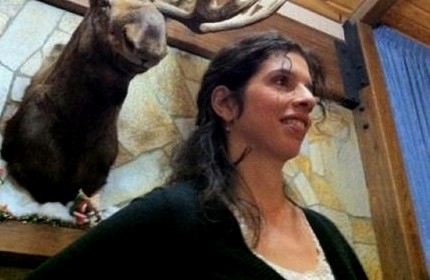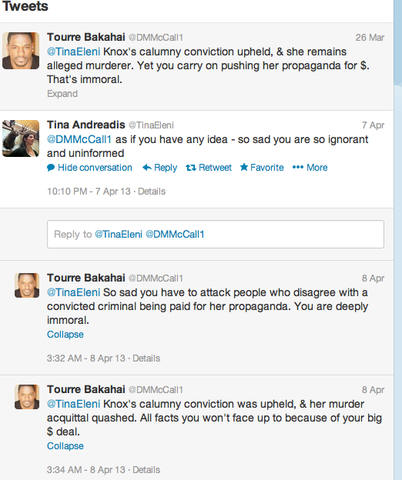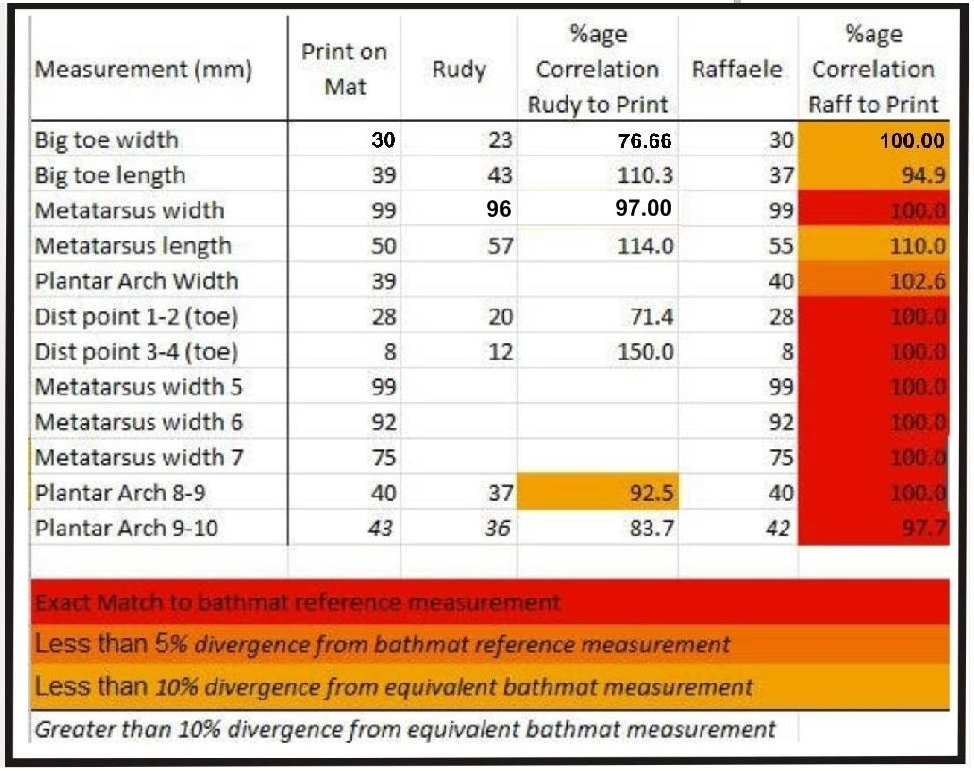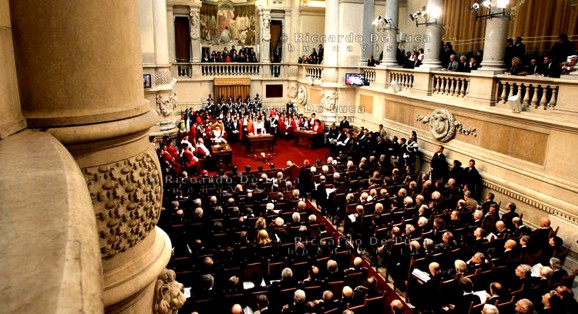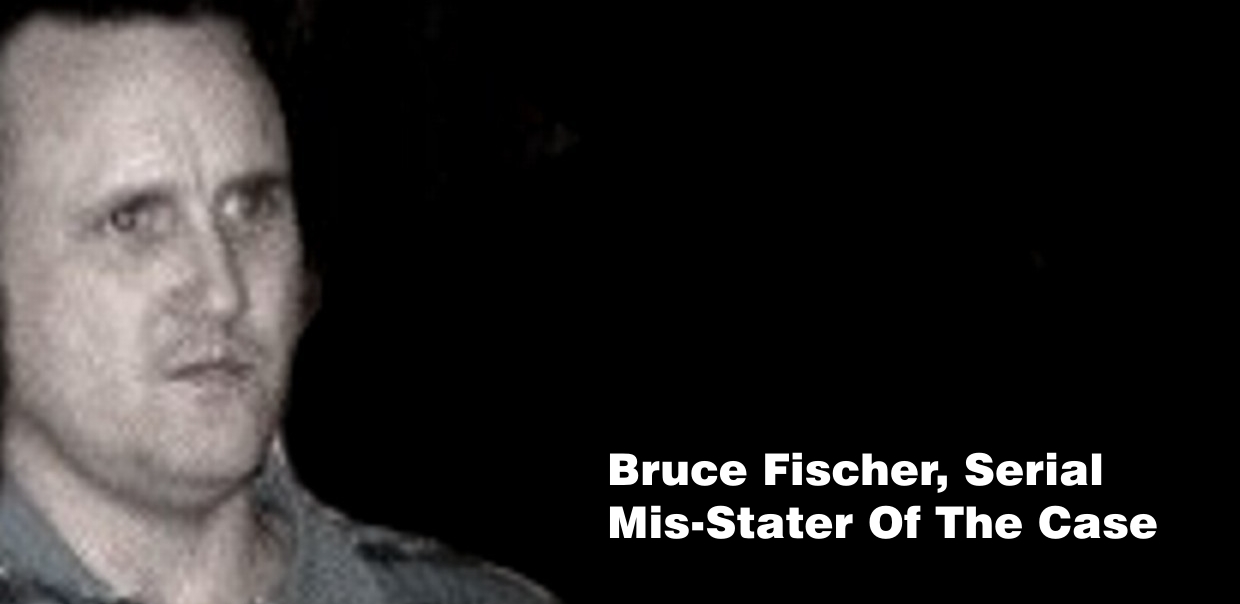
Political & economic headsup: US is demonstrating unsorted systems problems in spades. Do watch your investments. As Washington DC policy gets more & more off-target, big New York investors are betting very heavily that stocks will soon crash. Gross systems mismanagement 2017-20 tanked stocks several times.
Wednesday, May 01, 2013
Although The YouTube Trailer Suggests Diane Sawyer Wimped Out And Turned All Mushy…
Posted by Peter Quennell
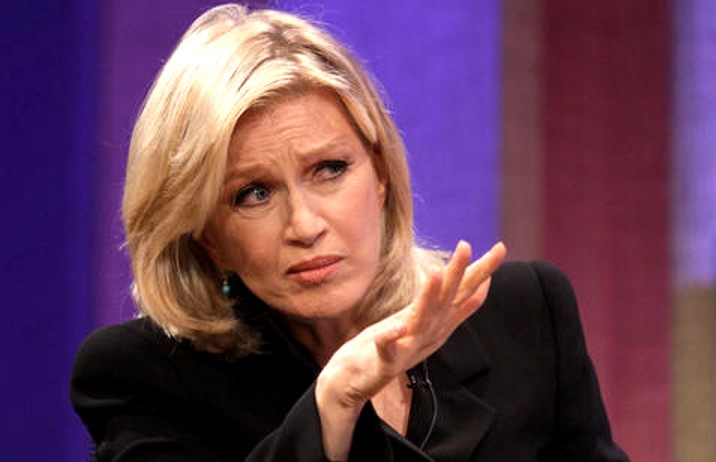
It could still be wrong. Trailers have been misleading before.
The interview is tonight at 10:00 on ABC. Our Main Posters Kermit and Media Watcher both have tips that could still win Diane Sawyer Pulitzer Prizes.
- Media Watcher: Diane Sawyer Interview With Amanda Knox: How To Push Back Against The False Claims And Emotion
- Kermit Powerpoint: Diane Sawyer’s Very Tough Interview With Amanda Knox: ABC Kindly Shares A Sneak Preview!
Here’s hoping. Even for Amanda Knox, our advice is usually the best. We’ll carry some sort of report on this tomorrow.
Friday, April 19, 2013
Twenty Forensic Reasons Why Guede Could NOT Have Attacked Meredith Alone
Posted by Cardiol MD
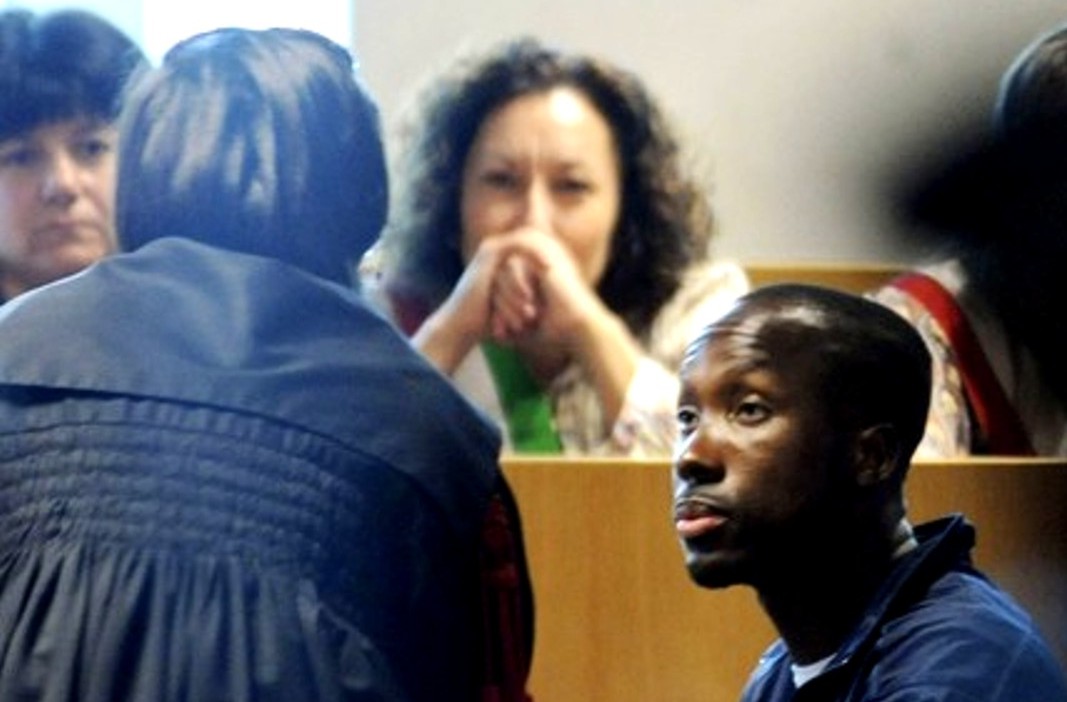
[Bongiorno in 2011 trying to rattle an unshakable Guede claiming Knox and Sollecito did the crime]
1. Guede Persona, An Overview
The convicted murderer Rudy Guede to this day claims that Meredith let him into the house, so we cut him no slack for that.
But at the same time he was no drifter or serial knife carrier, he had no police record in 2007 (unlike Knox and Sollecito), and no drug dealing or breaking-and-entering has ever been either charged or proved.
In October 2008 Judge Micheli mistrusted and sharply rebuked a witness who claimed it just might have been Guede who broke into his house.
Guede seriously discounted his role on the night of Meredith’s death, but some physical evidence (not a lot) proved he had played a part in the attack. Thereafter his shoeprints lead straight to the front door.
2. Moving Target In Court
Neither Judge Micheli nor Judge Massei nor the Supreme Court believed he acted alone or had any part in the very obvious cleanup that had been carried out.
The Knox and Sollecito defenses failed miserably to prove he climbed in Filomena’s window, and despite much innuendo they never really tried to prove he was a lone attacker.
That is why in 2011 we saw two of the most bizarre defence witnesses in recent Italian legal history, the jailbirds Alessi and Aviello, take the stand
Alessi became so nervous making his perjured claim that Guede told him Guede did it with two others that he was physically sick and had to take time off from the stand.
Aviello loudly proclaimed that his brother and another did it (not Guede) and then claimed the Sollecito family via Giulia Bongiorno floated bribes in his prison for false testimony.
Tellingly, although Bongiorno threatened to sue Aviello, she never has. Even more tellingly, Judge Hellmann himself initiated no investigation and simply let this serious felony claim drop dead.
Here is a far-from-exhaustive list of 20 reasons why Rudy Guede could not have acted alone. Also why not one scrap of evidence has ever been found for any two other than Knox and Sollecito themselves.
3. Twenty Lone-Wolf Disproofs
1. Guede’s Final Appeal Report said Meredith sustained 43 wounds
The testimony at the 2009 trial about the 43 wounds was presented in closed court out of humane respect by the jury for the feelings of Meredith’s family.
So even the diligent and trustworthy Italian media mostly missed this, as they were locked outside.
Mention of the 43 wounds was omitted from the 2009 Massei Trial Report and also from the 2011 Hellman Appeal Report.
Its inclusion in the December 2010 in Judge Giordano’s Supreme Court report on Guede’s final appeal reflects the report’s excellent factual completeness.
The PMF translation reads, in relevant part:
The body presented a very large number of bruising and superficial wounds – around 43 counting those caused by her falling – some due to a pointed and cutting weapon, others to strong pressure: on the limbs, the mouth, the nose, the left cheek, and some superficial grazing on the lower neck, a wound on the left hand, several superficial knife wounds or defence wounds on the palm and thumb of the right hand, bruises on the right elbow and forearm, ecchymosis on the lower limbs, on the front and inside of the left thigh, on the middle part of the right leg, and a deep knife wound which completely cut through the upper right thyroid artery fracturing the hyoid bone, a wound which caused a great deal of bleeding.
Including the number of minutes occupied by an initial verbal confrontation, the escalation of that confrontation into taunting and then the physical attack, leading to the infliction of 43 wounds, and to the fatal stabbing, how many minutes would all of this occupied?
The prosecution estimated it took fifteen.
2. Meredith had taken dance classes and played football & karate)
See the Massei Translation, p23.
Every day Meredith called her family, with whom she had a very close relationship. She had taken classes in dance and played sports (football, karate); she was a strong girl, both physically and in terms of temperament (cf. statements by her mother and by her sister Stephanie, hearing of June 6, 2009).
3. Meredith was a strong girl, physically and in temperament
See the statements by her mother and by her sister Stephanie (hearing of June 6, 2009). and description of her karate. (Massei Translation, pp23, 164, 366, and 369).
With regard to the totality of these circumstances, it must be considered that Meredith could only have made an outright refusal to Rudy’s advances and in doing so could also count on her slim [fit] physique, which the photos allow [one] to understand, [and] on her good athletic training (other than dance she had also done sports characterised by a certain physicality such as football, and had even taken a course in karate), sustained by her strong character.
4. Meredith must have been “strongly restrained”
See the Massei Translation, p371; p399, in the Italian original.
Conversely, considering the neck wounds sustained, it must be believed that Meredith remained in the same position, in a standing position, while continuously exposing her neck to the action of the person striking her now on the right and now on the left. Such a situation seems inexplicable if one does not accept the presence of more than one attacker who, holding the girl, strongly restrained her movements and struck her on the right and on the left because of the position of each of the attackers with respect to her, by which it was easier to strike her from that 372 side. One of these attackers was Rudy and the others were those who allowed Rudy to enter the house and who were with him in the house and who, in order to lead the nvestigations astray, then organised the staging of the broken window and the mess in Romanelli’s room: Amanda Knox and Raffaele Sollecito, according to all that has already been shown.
5. Meredith remained virtually motionless throughout the attack
That was in spite of Meredith’s physical and personality characteristics [Massei Translation p369] [Massei Translation p370-371].
A first indication to be taken into account is Meredith’s physical build: the photographs of her body and the data of her approximate height and weight reveal a physique with “normotrophic muscular mass and normally distributed subcutaneous fat” (cf. declarations Lalli p. 3), a slim physique which would have permitted Meredith to move with agility. To this must be added the declarations of the parents and the sister of Meredith. Her mother, Arline Carol Mary Kercher, recalled that Meredith had practised football and karate (p. 7 hearing 6 June 2009), and her sister, Stephanie Arline Lara, stated that Meredith also did boxing, if only the once, and that “physically she was very strong” (p. 20, hearing 6 June 2009). Also her father, John Leslie Kercher, declared that his daughter was quite strong and had taken a course in karate (p. 23 hearing 6 June 2009). It has also been noted that Meredith was not in bed and undressed when the “advances” and the attempts to subject her will commenced. Being still dressed and awake, and since it must be excluded because of what has been said above that the violent action could have taken place with Meredith lying on the bed, it is considered that she, who was sober and fully conscious since no traces indicating either the use of drugs or the abuse of alcohol were found, would have opposed a firm resistance, as she could claim a strong physique, experienced in self-defence by the lessons in karate that she had taken.
6. The defensive wounds were almost non-existent
See the report of Dr Lalli, pp. 33, 34, 35 with the relevant photos. Massei Translation p370.
The signs of this resistance, however, consist in a scream, the scream heard by Nara Capezzali at around around 23:30 and by Maria Ilaria Dramis when, having gone to bed at 22:00 pm, she awoke at a later time which she was not able to quantify; they consist also in some tiny defensive wounds: one on the palm of her [396] right hand of a length of .6cm showing a tiny amount of blood; another on the ulnar surface of the first phalange of the second finger of the left hand, also of length .6cm; another on the fingertip of the first finger with a 370 superficial wound of .3cm, and another tiny wound corresponding to the fourth radius. Compared with these almost nonexistent defensive wounds (cf. report of Dr Lalli, pp. 33, 34, 35 with the relevant photos), there is an injured area which is impressive by the number, distribution and diversity, specifically of the injuries (bruises and wounds) on the face and neck of Meredith.
7. One killer couldn’t inflict 43 wounds with so few defensive wounds.
See the Massei Report quotes above.
8. There must necessarily have been two knives at the scene of the crime
See the Massei Translation p377.
Even this consideration, therefore, leads one to hold that the biological trace attributable to Amanda and found on the knife handle, could have derived from the use of the knife for the purpose of striking, rather than to cut food; it could have derived, therefore, from the harmful action carried out against Meredith and as a consequence, a biological trace attributable to Meredith remained in the tiny striations present on the face of the blade, in spite of the subsequent cleaning, and which does not appear otherwise explainable as to how, in this regard, it was to be found there (Meredith had never been in Raffaele Sollecito’s house and could never have used this knife). Moreover, the knife Raffaele Sollecito carried with him had a definitely shorter blade as has been seen than the length that would have been necessary for causing the deeper resulting wound, with a depth of 8cm, and therefore, there must necessarily have been two knives at the scene of the crime, first one, and then the other, being used against Meredith.
9. A lone killer would need one hand/arm or both to restrain Meredith
So how could he use 2 knives? To use 2 knives a lone killer would have to place 1 knife down, leaving blood-stain[s] wherever it was placed, and then reach for the other knife.
Even wiping the blades on the killer’s clothes, using the one hand, and later scrubbing of the knives would not erase all the blood, as has already been demonstrated.
10. Two killers could divide attack, one holding Meredith, both holding knives
Meanwhile the other killer used one hand/arm to restrain Meredith, and the other hand to use the various knives. Could a lone killer accomplish all that?
11. Meredith’s shoes, pants and underwear had been removed
See the Massei Translation p.370
“It is impossible to imagine in what way a single person could have removed the clothes that Meredith was wearing (shoes, pants and underwear), and using the violence revealed by the vaginal swab, could have caused the resulting bruises and wounds recalled above, as well as removing her sweatshirt, pulling up her shirt, forcing the bra hooks before tearing and cutting the bra.” [Massei Translation p.370]
12. Meredith’s sweatshirt had been pulled up and removed.
See the [Massei Translation p.370
Furthermore, it is impossible to imagine in what way a single person could have removed the clothes that Meredith was wearing (shoes, pants and underwear), and using the violence revealed by the vaginal swab, could have caused the resulting bruises and wounds recalled above, as well as removing her sweatshirt, pulling up her shirt, forcing the bra hooks before tearing and cutting the bra.
13. Meredith’s bra had been forcibly unhooked
See the Massei Translation p.370
14. Meredith’s bra had been torn
See the Massei Translation p.370
15. Meredith’s bra had been cut
See the Massei Translation p.370
16. Violence to Meredith was revealed by the genital swab.
See the Massei Translation p.370
17. In Hellmann appeal RS’s lawyers didnt allege lone killer
They themselves brazenly introduced false testimony to the effect that there were two other killers.
18. Even Hellmann didn’t deny the complicity of AK and RS
Even H/Z seemed to conclude they are probably guilty, but not beyond a reasonable doubt:
“| in order to return a guilty verdict, it is not sufficient that the probability of the prosecution hypothesis to be greater than that of the defence hypothesis, not even when it is considerably greater, but [rather] it is necessary that every explanation other than the prosecution hypothesis not be plausible at all, according to a criterion of reasonability. In all other cases, the acquittal of the defendant is required.” [H/Z p.92]
19. Judge Micheli, in Guede’s trial, found that Guede did not act alone
And that the evidence implicated Amanda Knox and Raffaele Sollecito as accomplices of Rudy Guede in the murder of Meredith Kercher.
20. Massei found that the evidence implicated AK and RS
He concluded they were joint perpetrators with Rudy Guede in the murder of Meredith Kercher.
4. Obvious Conclusions
Is it really reasonable to claim as Sollecito did in his 2012 book that Guede was a lone killer?
Doesn’t all this contradict the lone-killer theory, beyond a reasonable doubt?
Thursday, April 11, 2013
Knox Book Put On Hold In UK As Legal Implications Of Blood Money For Still-Accused Finally Sink In
Posted by Our Main Posters

There have always been several huge problems in the promotion of Amanda Knox.
One problem is that Knox is not the real victim in the case and a great deal of compassion still resides for Meredith. Earning windfall blood money from the cruel death of a claimed close friend is hardly a classy way to go.
A second problem is that we are still only at the end of the second act of a three act play in terms of the trials and appeals, and the Italian Supreme Court in the third act to come will almost certainly be no gullible pushover. And a whining or inaccurate book or movie demonising Italy and Italians (as her complaints about Capanne already have done) might not help her legal prospects one little bit.
A third problem is that Italy’s officialdom and its population tend to maintain a hard and unblinking belief in the evidence against Sollecito and Knox, especially as the million dollar PR campaign largely flew below the radar there and they saw much of the hard case and a callous Knox live on TV. For example in Florence and Milan....
*******
Guess when we first posted those paragraphs above? Actually we posted them fifteen months ago on 6 January 2012.
And finally today fifteen months later HarperCollins UK suspended their publication of Knox’s book. Can the HarperCollins US suspension of the book be far behind?
We are not particularly given to directing legal advice to Amanda Knox - we think she should rethink and answer all the open questions - but the leeching of Knox-Mellas blood money going back nearly five years is absolute anathema to Meredith’s family.
So we have posted five subsequent times, pointing out to the Knox-Melasses and Robert Barnett and Ted Simon what should have been very, very obvious to them when they did their due diligence in Italy on the book:
Publishing to impugn Italian justice officials while still accused in an ongoing legal process is a contempt of court felony in Italy.
Ask Raffael Sollecito. He is now under investigation by the Florence chief prosecutor and could face millions in damages and further years in prison. So could his publishers Simon & Schuster and his shadow-writer Andrew Gumbel.
Not to mention that Sollecito is probably wrecking any chances he had at the repeat of the appeal. Does Amanda Knox REALLY want to be in the same boat? And do her shadow-writer and her publishers too?
Here are our other previous posts on her book:
- Were Prospective Knox Publishers Given The Full Score On The Likely Legal Future Of This Case?
- HarperCollins: A Commendably Balanced Report By The UK Daily Telegraph’s Iain Hollingshead
- HarperCollins: Perhaps This Explains Why Jonathan Burnham Was Inspired To Take Such A Seeming Risk
- My Letter To Claire Wachtell of HarperCollins Protesting How Distasteful Knox’s Book Promises To Be
Below: The HarperCollins US publicist Tina Andreadis (aka Tina Eleni) participated in the very very very odd Twitter exchange at bottom. She seems unfamiliar with the concept of “contempt of court” and the criminal and civil nightmares headed Simon & Schuster’s and Sollcito’s way.
Perhaps Tina Andreadis was out of the loop when her publishing company did its due diligence.
Thanks to our main poster Bedelia for this astonishing catch.
Monday, April 08, 2013
Experienced Trial Lawyer: There’s Far More Evidence Than UK/US Courts Need For Guilt
Posted by SomeAlibi
The false claim “there is no evidence”
Some amateur supporters of Knox and Sollecito have committed thousands of hours online to try and blur and obfuscate the facts of the case in front of the general public.
Their goal is simple: to create an overwhelming meme that there is “no evidence” against the accused, and thereby try to create a groundswell of support. Curt Knox and Edda Mellas and Ted Simon have all made this “no evidence” claim many times.
At least some some of the media have eagerly swallowed it.
The amateur PR flunkies make up myriad alternate versions of what created single points of evidence, often xenophobic scare stories designed to trigger emotional reactions, which they hope will be repeated often enough to become accepted as “the truth”.
And where things get really tricky, another time honored tactic is to go on at great length about irrelevant details, essentially to filibuster, in the hope that general observers will lose patience with trying to work it all out.
But time and again we have shown there is actually a great deal of evidence.
Evidence is the raw stuff of criminal cases. Let me speak here as a lawyer. Do you know how many evidence points are required to prove Guilt? One evidence point if it is definitive.
A definitive evidence point
If you’re new to this case or undecided, what is an easy example of ONE definitive evidence item that might stand alone? Might quickly, simply, and overwhelmingly convince you to invest more time into understanding the real evidence, not that distorted by the PR campaign?
In fact we have quite a choice. See the footprint which was second on that list.
Now see the table above. I recommend the use of this table of measurement to avoid the lengthy back and forward of narrative argument which so lends itself to obscuring the truth. I would like to present you with this single table of measurements to give you pause to question whether this line that there is “no evidence” is really true or whether it might be a crafted deception.
I present here a summarized view of critical evidence which suggests with devastating clarity that Raffaele Sollecito was present the night of the murder of Meredith Kercher. No lengthy text, no alternate versions, just measurements.
This FIRMLY places Sollecito in the very room where Meredith was attacked and killed.
In the small bathroom right next to Meredith’s bedroom was a bathmat. On it was found a bloody naked right footprint of someone walking straight towards the shower in the bathroom. The blood is that of Meredith.
The footprint is not Amanda Knox’s - it is too big - but we can compare it to the prints taken of Rudy Guede and Raffaele Sollecito.
In Judge Massei’s report the multiple measurements were detailed in the narrative over many sentences and, in that form, their immediate cumulative impact is less obvious. It is only by tabulating them, that we are forcefully hit by not one but two clear impressions:
The measurements are extremely highly correlated to the right foot of Raffaele Sollecito in twelve separate individual measurements. In themselves they would be enough for a verdict of guilt in all but a few court cases.
But they also show a manifest LACK of correlation to the right foot of Rudy Guede, the only other male in that cottage on the night. Have a look for yourself.
If you were the prosecution, or indeed the jury, and you saw these measurements of Raffaele’s foot versus the print, what would you think? Answer the question for yourself based on the evidence admitted to court.
Then, if you compare further, exactly how plausible do you find it that the measurements of the bloody imprint are Rudy Guede’s instead?
Not only are some of the individual measurements of Rudy’s imprint as much as 30% too small, but the relative proportions of length and breadth measurements are entirely wrong as well, both undershooting and overshooting by a large margin (70% to 150%).
Conclusions that must follow
Presented with those numbers, would you consider those measurements of Rudy Guede’s right foot to show any credible correlation to those of the footprint on the mat?
Supporters of the two have tried frantically to create smoke screen around this - the wrong technique was used they say (ruled not so by the court) / they are the wrong measurements (all 32 of them? that Raffaele’s are matching exactly or within a millimetre but Rudy’s are out by as much as -30% to +50%...?).
The severity of the impact on the defence is such that there was even a distorted photoshopped version circulated by online supporters of Raffaele and Amanda until they were caught out early on in coverage. But it is hopeless, because these are pure measurement taken against a scale that was presented in court and the data sits before you.
Have a look at the measurements and understand this was evidence presented in court. Whose foot do you think was in that bathroom that night? Rudy Guede? Or was it Raffaele Sollecito on twelve counts of measurement?
And if you find for the latter, you must consider very seriously what that tells you both about the idea there is “no evidence” in this case and who was in the cottage that night…
Saturday, April 06, 2013
Giuliano Mignini Promotion Places Him First In Line For Prosecutor General of The Region Of Umbria
Posted by Peter Quennell
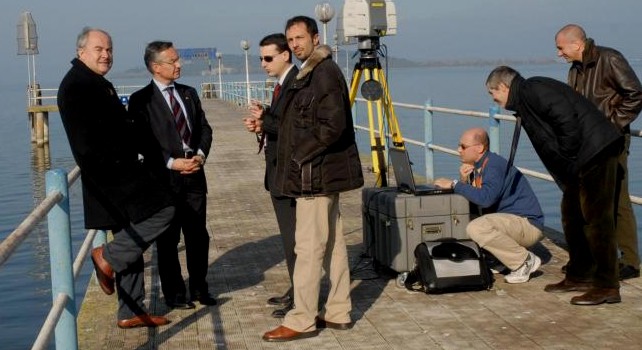
[Above: Giuliano Mignini at left at Lake Trasimeno where Dr Narducci’s body believed bound was recovered]
Umbria of course is the Region for which Perugia is the capital and the current Prosecutor General is Dr Galati who will soon retire.
The post that the popular Dr Mignini was promoted into on his high-scoring merit this past week is one of three deputy prosecutor general posts. The promotion was delayed because of the rogue prosecution against him which Cassation annulled, but he is the most senior and most high-scoring of the three so he should succeed Dr Galati.
We will post the full story (it is a long and impressive one) after our series of posts on the Cassation outcome is done. The story includes an almost unprecedented THREE Cassation wins in just the past several months.
- One obviously was Dr Mignini’s role in the overturn of the Knox-Sollecito appeal and confirmation of Knox’s felony conviction. His main role was to have presented an error-free case at trial in 2009 resulting in the solid grounding of the Massei Report just praised by the Supreme Court.
- One was the final termination of the spurious prosecution against Dr Mignini and Dr Michele Giuttari in Florence by a rogue prosecutor who was desperate to cover his tail after he was (legally) caught on tape incriminating himself.
- One was the Cassation decision to permit the reopening of the MOF-related Narducci case and to confirm that investigations and prosecutions against nearly two dozen who had been seemingly obstructing justice may proceed.
Congratulations to a fearless and effective prosecutor. We will update his full story here soon.
Friday, April 05, 2013
The New Palace Of Justice In Florence Where The Repeat of The Appeal Will Take Place
Posted by Our Main Posters

[Click above for a larger image]
The huge new Palace of Justice in north-west Florence was fully opened in January 2012.
It was built on the site of a former FIAT factory. It is Italy’s second largest Palace of Justice after that in Turin (in Rome the justice functions are still distributed) and one of the most modern and spectacular in Europe.
Several thousand people work in the building, including the judges, lawyers, clerks, police and support employees.
It houses all the civil and criminal courts for Florence, and the higher courts for the province of Tuscany. Also the chambers of the chief justice and all other judges. Also the office of the prosecutor general and chief prosecutor and all prosecutors. Also the office of the judges for preliminary investigations (GIP), and also all the associated police and support functions.
It was inaugurated on 23 January 2012 by the Minister of Justice Dr Paola Severino and the Mayor of Florence Mr Matteo Renzi (images below) and It frees up nine sites in the center of Florence for other business.
It was designed by the architect Leonardo Ricci (now deceased), is 240 meters long and 146 wide, with a tower of 72 meters, the second highest in the city. The occupied building area is about 800,000 square meters.
The largest courts are on the ground floor, and the upper floors house smaller courts and the offices for all the judges and prosecutors.

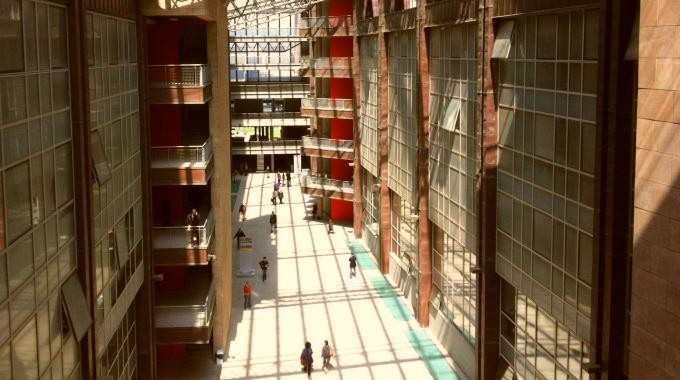
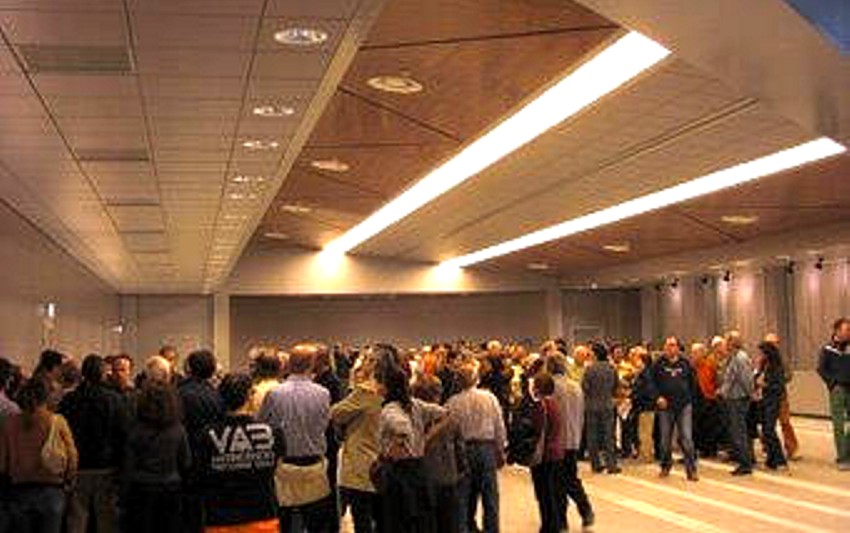
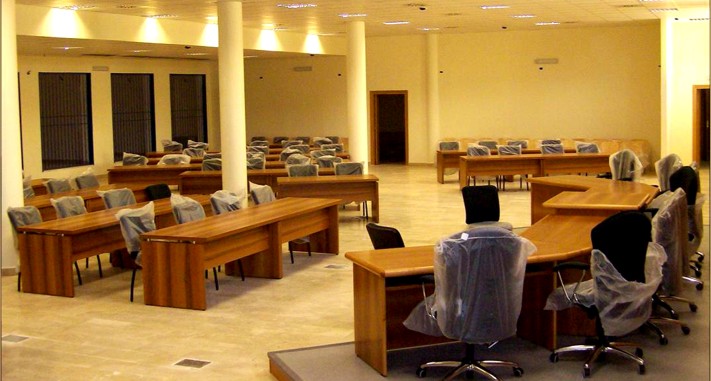

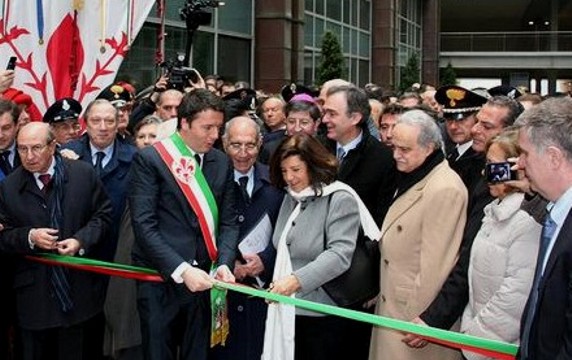
Above: the January 2012 inaugural opening ceremony. Front from the extreme left the Chief Prosecutor (red tie), the Mayor of Florence (red, white and green sash), the Central Government Minister of Justice (white scarf) and the Chief Judge (beige coat).
The Chief Prosecutor Dr Giuseppe Quatrrocchi and the Chief Judge Dr Fabio Massimo Drago will be ultimate overseers of the new appeal. They will appoint the prosecutors and judges who will preside.
The Chief Prosecutor is already heading a contempt of court investigation into the many false claims of criminal behavior in Sollecito’s book. He seems certain to need to do the same if Knox’s book transgresses.
False claims in either book may incur additional years in prison, and millions in civil damages.
Wednesday, April 03, 2013
The Real Catastrophe For The Defenses That Was The Chieffi Supreme Court Ruling
Posted by Machiavelli
1. Overview
On Tuesday March 26, nine judges of the Rome Supreme Court of Cassation led by the respected Dr Chieffi quashed the previous acquittals of Amanda Knox and Raffaele Sollecito for the murder of Meredith Kercher.
The Supreme Court annulled almost the entirety of the 2011 Hellmann-Zanetti appeal verdicts, declaring the appeal outcome completely invalid on five of the six charges. The Court only upheld the sixth charge which made definitive Knox’s conviction for calunnia for which she had been sentenced to three years.
Calunnia is the crime of maliciously placing false evidence or testimony against an innocent person, something the Italian Criminal Code considers not as criminal defamation but as a form of obstruction of justice, a more serious offence.
Worse for Knox, the Court annulled a part of the appeal verdict which had dropped the aggravation known as continuance, the aggravation that acknowledges a logical link between the obstruction of justice and the murder charge.
2. First reactions
Once the dust has settled, the defendants and pro-Knox and pro-Sollecito supporters and defences may finally realize how severe a defeat has been dealt to their side.
Most American journalists were completely unprepared for and very surprised at the outcome. But most Italian commenters and a very few others elsewhere considered the outcome quite predictable (the criminologist Roberta Bruzzone for example hinted so in written articles, so did Judge Simonetta Matone, as well as John Kercher in his book, and many others too).
This really is a catastrophe for the defences. A complete annulment of an acquittal verdict is just not frequent at all. They do occasionally occur, though, and this one appeared easily predictable because of the extremely low quality of the appeal verdict report.
For myself I could hardly imagine a survival of the Pratillo Hellmann-Zanetti outcome as being realistic.
I previously posted at length on the Galati-Costagliola recourse (that is an important read if you want to understand all angles of the annulment). I argued there that a Supreme Court acceptance of the verdict would have so jeopardized the Italian jurisprudence precedents on circumstantial evidence that it would have become impossible to convict anyone in Italy at all.
The previous appeal trial obviously violated the Judicial Code as it was based on illegitimate moves such the appointing of new DNA experts for unacceptable reasons. It contained patent violations of jurisprudence such as the unjustified dismissal of Rudy Guede’s verdict on a subset of the circumstantial evidence. Hellmann-Zanetti even “interpreted” the Constitution instead of quoting Constitutional Court jurisprudence.
They omitted a number of pieces of evidence, literally “forgetting” them or dismissing them without providing an argument (they should have, being an appellate trial based on the previous findings and arguments of the lower court). The appeal trial had obvious illogical contradictions on a macro level, such as the contradictory putting together of the conviction for calunnia and the acquittal on the murder charge (ignoring a logical link required by statute without introducing any reason at all).
The Hellmann-Zanetti verdict was also based on an illogical processing of all pieces of evidence (such as the dismissal of Nara Capezzali’s evidence without logical reason, even after calling her “credible,” and that of Quintavalle; and attributing the bloody footprint to Rudy Guede on the basis of some ludicrous reasoning).
The appeal verdict basically ignored the concept of “a contrario” evidence, like concluding that the luminol footprints are probably not in blood but in some other substance and not related to the murder (despite failure to indicate any alternative substance nor any reasonable scenario).
The verdict was also biased with open prejudice in favor of two of the suspects in assuming they would be unlikely to even socialize or hang out together with the third, based on social or racial discrimination (two whites from good-looking families are called “good fellows” while the third is “different”).
Beyond the glaring, major faux pas in procedure, the verdict’s low quality, unlawfulnesses, and hypocrisy in its reasoning tended to be pervasive and obvious through all its paragraphs, and possibly this also could have caused an aura of distrust toward the work of the Hellmann-Zanetti court.
One could assess the strikingly low quality of the appeal verdict especially by comparing it to a sophisticated recourse such as the 100-page Galati-Costagliola Supreme Court appeal. While nobody could anticipate with total certainty the Supreme Court decision between the Galati-Costagliola appeal and the Pratillo Hellmann-Zanetti appeal verdict, to good legal eyes the outcome would be as uncertain as the result of an England versus San Marino football game!
EACH of the eleven single mistakes, plus EACH of the six “method” mistakes pointed out in the Galati-Costagliola recourse could by itself have been a sufficient cause for the annulment of the acquittals.
The redundancy of reasons and remarks by Cassation sheds light on the judgment shortcomings from many different angles, and all the reasons presented for the recourse were certainly assessed by the Supreme Court.
But on the practical side, most probably the Hellmann-Zanetti verdict did not even survive beyond the first mistake. The appeal verdict most likely crumbled completely from the very beginning on reason #1, the illegitimate appointing of new experts by Hellmann-Zanetti to re-examine the DNA.
But even given that the defences’ defeat could be foreseen, I never expected the defeat to pervade to this extent.
I thought the appeal verdict might be quashed entirely and a new appeal would start from scratch. But the Supreme Court went further and decided to “save” only the parts of the verdict that were unfavorable to Knox, and declared her conviction for calunnia definitive.
Meanwhile, the Court accepted the Calati-Costagliola reason #10, and quashed the part that denied a logical link between calunnia and murder.
The Supreme Court thus sends Raffaele Solecito and Amanda Knox back to appeal trial, but this time Amanda Knox will enter the trial as a felony convict with a definitive criminal record, which ““ the Supreme Court hints ““ is to be considered logically linked with the charge of murder.
Moreover, judges in the appeal that will come next in Florence will have to follow the decisions set by the Supreme Court. Since the Supreme Court’s motivations report has not been issued yet, we still don’t know what points exactly Cassazione will make. But we can expect that several arguments used by Pratillo Hellmann-Zanetti that were “needed” to acquit Knox and Sollecito will be now declared illegitimate.
This might mean that we will not see for a second time such faulty reasoning as “Knox’s statement can’t be used as evidence of lying because it is not true.” It may not be possible to dismiss the verdict that found Guede guilty of concurring in murder “with others” from the set of evidence just because it was “weak.” It may not be possible to deduce the time of death based only on declarations of Rudy Guede.
We also may not have a chance to again see an expert declaring that contamination is “likely” on the sole basis that “everything is possible.” We also may not have another judge attributing footprints without talking about any measurements.

The Supreme Court session began on March 25, and it is only a rare event that a Cassazione session extends over into two days.
The first criminal division of the Supreme Court ““ scheduled to decide on this case ““ was a five-judge panel presided over by Dr Severo Chieffi. His name never did sound like a particularly favorable omen for Knox and Sollecito. Dr Chieffi is a 70-year-old judge, known for being the author of a famous 2008 verdict which definitively closed a notorious criminal case (“the first time a Cassazione hearing attracted massive live media attention”), a verdict among the most quoted in jurisprudence which is known as that “on reasonable doubt.”
Dr Chieffi and his nine-judge panel explained reasonable doubt as to be intended as an “a contrario” concept, the concept used to formulate a logical reasonable alternative. That verdict pointed out the concept of “reasonable” and also stressed that the nature of evidence is “logical”. “Reasonable” depends only on the plausibility of alternatives, not on how conclusive or reliable single pieces of circumstantial evidence are, and a piece of evidence does not require any specific “physical” element or conclusive quality.
The rapporteur judge was Dr Piera Maria Severina Caprioglio. The rapporteur judge goes through the papers of the whole trial and summarizes their content to the other panel judges; the rapporteur and the president are the two who physically write the report (it may sound like irony that both judges have the adjective “severe” in their name). I was told Dr Caprioglio was a rather stiff judge, known for her scrupulosity in procedure matters, and she is also a specialist “and hard liner“ about sexual crime (maybe that’s why she was chosen by Dr Chieffi as the one to do the research on this case).
At the Supreme Court there is also an office known as the Office of Procurator General, which has more than 50 magistrates. The Procurator General appoints a magistrate (normally called the “PG”) to study cases and to make arguments on all cases dealt with in Supreme Court sessions. The PG is considered “neutral” in the sense that their office represents no party only the “precedents” of the court. While the rapporteur makes a description of the case, the procurator makes arguments about the recourses submitted by the parties.
At 10:30 am on Monday, Judge Caprioglio begun her 90-minute speech summarizing the case. She detailed legal events that led to the first Massei-Cristiani verdict, and then the appeal trial led by Hellmann-Zanetti and their verdict.
She sounded rather neutral; hers was a sheer summary with no comment attached. Nevertheless, it sounded most ominous for the defences: right from Dr Caprioglio’s speech, in fact, Knox and Sollecito’s attorneys understood that they were going to lose.
This is because Dr Caprioglio devoted half of her rapporteur time or more to detailing Massei’s first degree trial and verdict, explaining the arguments and evidence used by the Massei court. Such attention was itself ominous to the defences.
A main basis of the Pratillo Hellmann-Zanetti verdict is in fact a series of denials about the work of the lower court, in which plenty of evidence was simply ignored or dismissed without dealing with the first degree conclusions; while the strategy of Giulia Bongiorno was to entirely “replace” the details of the evidence set with a self-made narrative, quite unattached to actual trial events, which somewhat “worked” as rhetoric and in the media.
Yet Dr Caprioglio was not yet the biggest problem facing Knox and Sollecito. The defence was about to face a pincer front, because the Procurator General’s offices did not appreciate the appeal verdict at all.
A bomb went off with the speech of Procurator Riello which followed next.
Dr Riello recalled the points of recourse submitted by Galati-Costagliola, which may sound technical or subtle to those unaccustomed to them. Dr Riello endorsed the radical censures made by Galati-Costagliola and made clear his own view in an overview of the whole verdict. His arguments had the subtlety of an anvil.
To summarize, he basically maintained the appeal judges had conducted an appeal trial as if they were idiots, and followed the paths of logic, procedure and law like sailors without a compass.
Seen from the point of view of the Procurator General, their way of conducting the appeal trial itself was like a journey through a dreadful series of unlawful steps, decisions informally taken without deliberation, and arbitrary and unjustified ordinances. The court simply “lost their way.”
In the body of their findings, it seems they understood almost nothing about the evidence ““ in particular about how circumstantial evidence works. They did not deal with the findings and arguments of the first instance court as they should have, as if they didn’t exist, and they trivialized the previous legal material.
In fact Dr Riello sounded almost sarcastic; outraged by the incredibly amateurish work of this appeal court, he tended to detail the merit of questions and was interrupted by the president asking him to stick to the discussion on the table.
At the close of his speech, he called the appeal verdict “a rare concentration of law violation, a monument to illogicality.” He said “the judge of merit lost their way in this trial.” Dr Riello noted “they fragmented, they parceled out the pieces of circumstantial evidence.”
He implied not only incompetence but a kind of disingenuous attitude: “The Court employed a fair dose of snobbism for trivializing the first degree verdict, reducing it to four elements. A very imprecise and superficial synthesis.”
He went beyond the criticism expressed in the Galati-Costagliola appeal when he described an obvious bias of the appeal court “not in just a few passages of the second instance verdict ““ it’s as if the defendants should benefit from a kind of anthropological and cultural immunity, in relation to the events.”
He criticized Pratillo Hellmann’s dismissal of Amanda Knox’s handwritten memoir, and recommended that a new appeal trial must in part be based on that statement as “it is a usable document”; and he stressed that in his opinion “the scream heard by Amanda is a significant datum, of great importance.” The behavior claimed by Knox on the morning of November 2, 2007 in his view was “chilling” and her taking a shower in a cold bathroom is a “chilling detail.”
Dr Riello concludes by saying: “These are all conditions for not letting the curtains close on an upsetting and extremely serious crime for which the only culprit found up to the present day is Rudy Hermann Guede, who has been addressed through a Lombroso-style assessment, either calling him a thief, a criminal or a drifter. He didn’t confess and he was not convicted by another court for concurring in a crime together with others, maybe with ‘ectoplasms.’” (A reference to Cassation’s previous decision that he did commit the crime with others, but Hellmann-Zanetti identified no other people; hence ‘ectoplasms.’)
The Prosecutor General also dealt with the DNA experts’ report which defined the previous results as “unreliable.” He implied that the report and its language were used as a pretext by the defences “as a tombstone, while in fact it is not.” It was used as a tool to focus the trial on the DNA and steer it away from the whole evidence set, to “bury the set of pieces of circumstantial evidence which all have their vital value.”
The rhetoric of the defences aimed to “blame everything on those involved in the scientific police who are almost depicted as bunglers; however they are not brigadiers playing with toy chemical sets, they are in fact a highly qualified department and they do employ cutting-edge technologies.”
A severe legal bashing like the Riello speech is not at all common at the Cassazione. As I heard the news on the radio, law experts commented that the event was unusually serious, and they hinted that its consequences may lead to the setting of a historic jurisprudence precedent.
Francesco Maresca ““ who brought his mentor Vieri Fabiani with him ““ endorsed the recourse points and made points similar to Dr Riello’s. He pointed out that a major flaw of the appeal trial was to focus on two DNA instances as if the case was based on them. The court appointed experts to review items with no legitimate basis, they provided an inconsistent explanation for their steps, and then they refused to analyze and introduce further evidence, totally contradicting themselves and also violating the code.
Their criteria for choosing which piece of evidence to discuss or review were totally contradictory, and their series of steps egregiously violated a series of procedural conditions that any court is supposed to follow.
The analyzing of the knife DNA sample and bra clasp sample as pieces in isolation is a sort of device that serves a defence made-up narrative; the focus on “disputed” items and the re-make of a narrative about legal events is simply a defence strategy which is aimed at the media rather than official court proceedings. For the Kercher family, the evidence points to the guilt of Knox and Sollecito beyond reasonable doubt.
The evidence, explained Maresca, consisted of numerous pieces of evidence and reasoning, that were simply not dealt with by the appeal court. The whole process was “non-transparent” and the result is also contradictory given that Knox is indicted by her own words on the crime of calunnia.
Maresca explained that the appeal verdict is riddled with many flaws and errors in the merit of the facts which cannot be assessed by the Cassazione court, but there are also patent violations of law which are “strong and obvious” and of the most serious kind.

Then it was the defence attorneys’ turn. Giulia Bongiorno knew she would need to apply the full power of her best rhetorical skills: she pointed out a factual error in the recalling of Prosecutor Riello and threw herself head-first into the merit of the evidence.
She even made FOA-style overstatements on the number of Guede’s DNA instances: “So many genetic traces of Rudy Guede were found in the bedroom of the murder, Amanda and Raffaele’s DNA would have been found too if they had been there.” (Her claim is false: in fact, only four samples yielding Guede’s DNA were found in the bedroom, and some were very scant.)
Bongiorno focused on investigation mistakes and complained that Raffaele Sollecito “was put in jail because of a shoe print found beyond the duvet which covered the body, a print that was attributed to Guede.” She also commented on Knox’s handwritten memoir and again put forward the claim ““ already rejected by all the judges of all instances ““ that the statement should be “not usable” because there was a “blackout” of defendant guarantees. Apparently, Bongiorno did understand that the most dangerous threat, and the actual battleground, would be about the danger of having Knox now definitively convicted for calunnia.
Bongiorno said “we do not want to put the scientific police on trial” but then said the point defence demonstrated was that they made “an infinite series of errors.” In fact, Bongiorno’s speech largely consisted of the well-known defense stance of pointing the finger at a list of supposed wrong-doings by the police.
Bongiorno’s argument of pointing out supposed “police mistakes” would probably ring true to Knox’s Amarican supporters, who may find these arguments convincing and effective.
In fact, it was obvious that Bongiorno’s position was extremely weak, and that her arguments were not going to have any effect. The weakness of Bongiorno’s arguments was obvious from the start because she backed into arguing the case only on the merit of investigation techniques.
Her arguments would maybe resonate effectively with uninformed spectators, but they had already failed in those courts that were legitimate, and they have no consequence from a legal standpoint. Talking about supposed mistakes during the investigation and supposed bad behavior of police are good to build a narrative for journalists, but they would have zero effect on expert judges.
I think she knew she was going to lose, but besides being a lawyer, Giulia Bongiorno is also a smart public person, and she plays in the public arena as well as in a court of law at the same time. Her technical stances are all wrong, but she knows she will be remembered well for her good-looking performance.
The president did not interrupt her, showing due politeness toward the defence attorneys. But no attorney would convince the Supreme Court by simply saying “we demonstrated that the investigators made mistakes.”
In order to seek to obtain some positive effect, she should have argued in favor of the Pratillo Hellmann-Zanetti appeal verdict on points of law, and put forward arguments for their legitimacy; for example, an argument in response to point #1 of Galati’s recourse claiming that the appointing of DNA experts was unmotivated.
Luciano Ghirga and Carlo Dalla Vedova had to take care of their own recourse against the conviction for calunnia on the false accusation of Patrick Lumumba. Their line of defence on this point was the same ““ and could be nothing else ““ than what they maintained though all the previous instances. Dalla Vedova deals with the handwritten note where he understands “Amanda says she is confused, she does not care about what she said.”
They reintroduced the myth that “she had been interrogated by the investigators for 54 hours.” They explain ““ almost a paradoxical argument ““ that the document was “a defensive paper” while then becoming one of the elements on which the charge of calunnia was built. They stressed that “she wanted to cooperate” with the investigation and that “she was a friend of Meredith.”
A failure of their arguments was easily predictable because their recourse was built on points that had already failed at lower instances. Some time ago before this appeal, I posted this criticism of the Ghirga-Dalla Vedova recourse on Knox’s calunnia conviction to the Supreme Court:
Pages 3-11: The first argument is about the non-usability of the evidence for the crime of calunnia.
Such an argument is basically the re-proposal of the same argument that had been already dismissed by the Supreme Court in 2008, and subsequently by Massei-Cristiani in 2009 and also by Pratillo Hellmann-Zanetti. Therefore, it is an especially weak argument. Ghirga-Dalla Vedova do attempt to use it again at the Supreme Court because it is what they have.
Just like Giulia Bongiorno will likely recall it too, just like she attempted to request of nullification of Stefanoni’s testimony on procedure grounds before Massei, which was rejected again by Hellmann-Zanetti (the Knox supporters have such a spun perception of the proceedings, they apparently don’t see how some basic defensive claims were rejected by all judges).
Pages 11-14 complete the first argument, addressing the further requirements of the crime of calunnia (maliciousness and voluntarity).
Basically, this point contends that the false accusation was not voluntary or not malicious. The only usable point in my opinion in this reasoning consists of one line, which recalls that Hellmann-Zanetti did not acknowledge the aggravation of continuance for the crime of calunnia. But this point has no consequence because it is a weak point in Hellmann’s verdict itself which violates jurisprudence and logic itself.
The other claims at this point are basically useless; they attack the Hellmann verdict in a way peculiar to the prosecution appeal with an opposite stance. But in fact “not knowing” that someone is factually innocent obviously cannot be extended to an absolute meaning; Hellmann is illogical on that, because he dismisses the logical link with the murder without explanation.
Pages 14-18 speak about the alleged “extreme exhaustion” of Knox in order to exculpate her of her confusion and falsehood.
This argument tends to be a stronger attempt to use some of the contradiction in Pratillo Hellmann-Zanetti, using as a starting point the fact that H-Z did state that Knox was allegedly under excessive pressure. They convicted her for calunnia nonetheless. I think this argument won’t go too far, for two reasons.
First, because it’s basically on the merits; it quotes the whole writing of Knox and requests the SC to directly re-assess the sincerity of her words, something which the SC are unlikely to do.
Second, because while on the one hand there is a contradiction in H-Z as they accuse her of calunnia but do not use her writings as an evidence of lying on the other crime, and they reject the continuance despite the obvious link between the calunnia and the murder, on the other hand the contradiction addressed by Ghirga is weaker. There was in fact no factual finding about “excessive pressure,” neither in the H-Z appeal trial nor in previous Massei testimonies.
As for jurisprudence, pressure and “psychological alteration” itself is not enough to cause a loss of mental faculties to understand and will. Basically, most crimes are committed in a state of psychological stress or alteration, and people are responsible for themselves notwithstanding. The faculty to understand and will is not a psychological condition; it is something that affects the cognitive and decisional functioning of the brain on more basic functions, and requires a medical assessment.
So there is no way the argument of Ghirga-Dalla Vedova can overturn a conviction for calunnia based on an argument of psychological conditions: they have no basis; and there is no consistent ground to assert “excessive pressure” either.
Pages 19-20 is a very short argument about two articles of the code that Ghirga puts in in relation to a case of defensive rights.
This is an argument I am unable to assess clearly. This point basically claims Knox is somehow protected by the law because of an extension of her rights of defence. I have the feeling this point is wrong, because the boundaries of the right to defend oneself are already fixed and limited by a SC ruling of 2008, and because Article 51 only applies to what she declared as a defendant, but not to what she declared as a witness.
Pages 20-22 is only about the sentencing and not about innocence; it claims that, anyway, even if Amanda is guilty of calunnia, the punishment was too stiff and this severity was not logically motivated by Hellmann. This point is the only that could stand, in my opinion.
After the hearing of March 25 ““ which was the ninth case the Supreme Court panel dealt with that day ““ the panel deliberated for six hours, then adjourned the hearing and scheduled the final decision for the following morning.
The question whether to annul the verdict entirely, or to confirm the calunnia conviction, might have been the cause of some of the extra time needed.
When the Supreme Court has to deal with scheduled cases the relator puts a mark ““ between 1 and 8 ““ indicating the difficulty of the case: 1 is the easiest and 8 is very complex.
Almost all recourses are below 3, while a case like the one on the Narducci investigation a week earlier, involving Mignini, could have been closer to 8. The difficulty of this case is unknown. But because of some sensitive jurisprudence involved and because of the articulation of the recourses, this could have been around 6 or higher.
After retirement of the court, and adjournment to the subsequent day, at 10 am on March 26, the court’s dispositivo was the following:
ENDING THE RESERVATION FROM THE HEARING OF 03-25-2013, [THE COURT] DECIDES AS FOLLOWS: ANNULS THE IMPUGNED VERDICT, LIMITED TO THE CRIMES UNDER CHARGES: A) (INTO WHICH CHARGE C) IS ABSORBED), B), D), E), AND TO THE AGGRAVATING CIRCUMSTANCE UNDER C.P. ART. 61 NO.2 IN RELATION TO CHARGE F), AND REMANDS [THE CASE] TO THE CORTE DI ASSISE DI APPELLO OF FLORENCE FOR A NEW TRIAL. REJECTS THE APPEAL OF AMANDA MARIE KNOX, WHOM IT SENTENCES TO THE PAYMENT OF COURT COSTS AS WELL AS REIMBURSEMENT OF EXPENSES INCURRED IN THE PRESENT PROCEEDINGS BY CIVIL PARTY DIYA LUMUMBA, IN THE AMOUNT OF 4000 (FOUR THOUSAND) EUROS, IN ADDITION TO I.V.A. AND C.P.A., PLUS GENERAL EXPENSES ACCORDING TO LAW.
Thus, Amanda Knox and Raffaele Sollecito are sent back to appeal trial in Florence on all charges related to the rape and murder of Meredith Kercher (a, b, c, d, e). And Knox is definitively declared guilty of the obstruction of justice charge known as calunnia, while the argument denying any logical link between the calunnia and the murder is quashed.
Resources used
The article above draws in part upon a translation into English of news information published by various Italian press sources, which our readers may like to look at directly. A good coverage of the case ““ including Riello’s speech ““ was broadcast by RaiNews 24 and they also have a lot of information on the website. Online updates were provided by Televideo. Commentaries and discussions were hosted on Radio1 - GR Rai. Dr Riello’s comments were reported by Il Fatto Quotidiano and Style.it. There were reports on Libero Italy.it. Also details and chronicles were reported at the end of the day by Il Giornale dell’Umbria. Coverage and the quotes for March 25 were provided by AGI. The dispositivo official document was obtained and published by Andrea Vogt.
Tuesday, April 02, 2013
A Growing Number Of Commentators Are Objecting To Overexposure Of The Two Still Accused
Posted by Peter Quennell

We have a series of posts coming up that will describe in detail and analyze the outcome of the Supreme Court.
At least one post will be a roundup of the media. Noticeable this time was less of a tendency to lionize Knox and Sollecito. Some articles and TV reports flipped for Knox, but none did for Sollecito.
And some editors and reporters have weighed in strongly for better balance. David Barrett of the Daily Telegraph wrote this one.
The impending retrial for the murder of British student Meredith Kercher fills many court-watchers with dread, myself included.
Details of the crime are horrific enough. But during the lengthy court processes which we have already witnessed, my discomfort was intensified by the obsession with Amanda Knox.
The photogenic young American, now 25, was convicted and then acquitted of the 2007 murder. She received more sympathy than most suspects who have ever stood in the dock on such a serious charge.
The media pack which followed the Italian trial would often comment on Knox’s apparent frailty; the “stress” she was suffering or whether she looked “pale”. It made me gag.
It’s a difficulty with which any professional and humane court reporter is familiar: how do you keep the victim, who is absent, visible in the very human drama that is a murder trial?
Is it appropriate to pay more attention to the suspect than to the issue at hand; namely, securing justice on behalf of a person whose life has been taken from them? I say it is not, although I can understand why it happens….
When the Italian prosecutors again attempt to secure a conviction for that tragic murder in Perugia we will have to get used to seeing Knox’s face on a daily basis once more. But let’s ensure that Meredith remains at forefront of all our minds.
.
Monday, April 01, 2013
One Final Word On Nina Burleigh In Response To Those Still Hoaxed By Her
Posted by The Machine
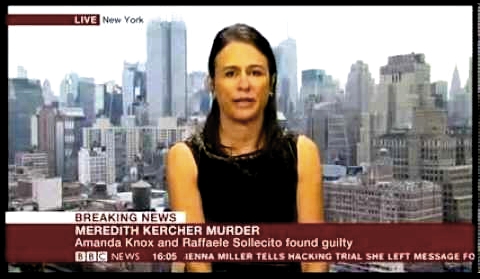
Actually Burleigh didnt get very much right.
Many of the pro-Burleigh commenters on the Time website and also many reviewers on Amazon dont seem to realise just how hard-and-fast Burleigh played with the facts.
I’ve dipped into the book and read various articles and they all stray far from the truth. Here is our review of one major aspect of the book explaining some of her extreme biases.
Poor grasp of Italian law. Poor understanding of the evidence. Terrible fact checking. Emotions run wild. Zero grasp of the Italian language. They result in very inaccurate work. Lack of Italian is her Achilles heel.
Challenges scroll fast on the Timewebsite. So here below are ten quick examples for Burleigh readers to show how easily and often she screws things up.
1. She falsely claimed in her book The Fatal Gift of Beauty that Meredith Kercher was born on 28 December 1986 (The Fatal Gift of Beauty, Dramatis Personae).
According to the Massei report, her actual birthday is 28 December 1985 (p23).
2. She falsely claimed in her book that Rudy Guede was on 26 December 1983 (The Fatal Gift of Beauty, Dramatis Personae).
According to Rudy Guede’s sentencing report, he was born on 26 December 1986 (p2).
3. She falsely claimed that Rudy Guede’s DNA was inside Meredith’s purse (The Fatal Gift of Beauty, p14).
According to the Massei report, his DNA was found on Meredith’s purse (p43). The Micheli report specifies that his DNA was found on the zip.
4. She falsely claimed that Rudy Guede’s prints were on Meredith’s walls (The Fatal Gift of Beauty, p14).
The Scientific Police were unable to identify any fingerprints on Meredith’s walls. Guede was identified by a bloody palm print on a pillow case. (Micheli report, pages 10-11, The Massei report, p43, Rudy Guede’s sentencing report, p5).
5. She falsely claimed on the Sound Authors website that Mignini accused Knox of a satanic rite.
Mignini has never claimed Meredith was killed during a satanic rite. In fact, he has specifically denied ever claiming this.
In his letter to LInda Byron, he stated the following: “On the “sacrificial rite” question, I have never said that Meredith Kercher was the victim of a “sacrificial rite”.
Mignini told Drew Griffin the following in an interview on CNN: “I have never said that there might have been a satanic rite.”
6. She falsely claimed that Amanda Knox described a “vision” in her handwritten note to the police (The Fatal Gift of Beauty, XXIV Timeline).
Amanda Knox never claimed she had a “vision” in her handwritten note or any of her witness statements.
7. She falsely claimed in Time that there were only two elements of “material evidence” against Knox and Sollecito.
These were Sollecito’s DNA on Meredith’s bra clasp and Meredith’s DNA on Sollecito’s kitchen knife.
But according to the prosecution’s experts, there were five instances of Knox’s DNA or blood mixed with Meredith’s blood in three different locations in the cottage. Even Amanda Knox’s lawyers conceded that her blood had mingled with Meredith’s blood.
In other words, Meredith and Amanda Knox were both bleeding at the same time.
According to the imprint experts, the bloody footprint on the blue bathmat in the bathroom matched the precise characteristics of Sollecito’s foot, but couldn’t possibly belong to Guede.
Knox’s and Sollecito’s bare bloody footprints were revealed by Luminol in the hallway.
8. In the same article, she falsely claimed that the knife was picked at random.
Armando Finzi was the police officer who bagged the knife. He testified that he thought it was the murder weapon because it was compatible with the wound on Meredith’s neck.
9. Another false claim from the article was that Rudy Guede left fingerprints at the crime scene.
He didnt. None at all. No prints were found of Guede.
10. In an article for the Columbia Chronicle she falsely claimed that freedom of speech doesn’t exist in Italy.
Pretty bizarre. She should learn to read some Italian. They have as many freedoms as those in the US and UK. And the incarceration rate is 1/7 that of the US.
11.She falsely claimed in Time that the prosecutors painted Amanda Knox as an “angel-faced she-devil”.
It wasn’t prosecutors who painted who Amanda Knox as a “she-devil”, it was Carlo Pacelli, the lawyer who represents Diya Lumumba, at the trial in 2009.
Carlo Pacelli’s comments were widely reported by numerous good journalists who were present in the courtroom, so this would have been really easy to check. .
Barbie Nadeau describes the moment he referred to Knox as a she-devil in some detail in Angel Face:
“Who is the real Amanda Knox?” he asks, pounding his fist in the table. “Is she the one we see before us here, all angelic? Or is really a she-devil focused on sex, drugs, and alcohol, living life on the edge?”
“She is the luciferina-she devil.” (Barbie Nadeau, Angel Face, page 124).
About Mafia Tool Bruce Fischer And Financial Fraud Elina Miettinen
Posted by Peter Quennell
1. Mafia Tool Bruce Fischer
Bruce Fischer caused wide amusement when he first revealed himself online slobbering ardently over Knox.
He was not by any means the only Knox-slobberer. Quite a few other men and even several women developed a bad attack of Killer Groupie Syndrome over Knox (actually, Knox 2.0, reconstructed by the PR as a virgin in widow’s weeds).
The Knox-Mellases also steered Steve Moore, Frank Sforza, and various others away. But for a while there, Bruce Fischer as “Bruce Fisher” pretty blatantly let his perversion hang out.
Fischer’s real name was hidden with great effort for more than two years by “Bruce Fisher” to allow him to slobber on over Knox, to not have his wife and her family realize, to defame others freely by their real names, and to scream “pervert” at many with no proof.
He is known to have posted under other names about the amazing “Bruce Fisher of New York” and his brilliance. We were told all to be in awe - though Fischer’s obviously dim grasp of the evidence was a major joke.
Accidentally “Bruce Fisher” allowed his real identity to become known and he fled the pro-justice sites, thereafter to build his own nasty forum and to vent his bitterness upon the world.
- It was revealed that he had been a mere floor assistant at York Furriers, in a shopping mall 35 miles north-west of Chicago and was laid off.
- It was revealed that his education is pretty basic and his professional skills relevant to elaborating on the Perugia investigation roughly nil.
- It was revealed that from his schooldays he has been known even among his friends as a hothead with poor people skills and thinking skills.
- It was revealed that he had declared personal bankruptcy twice and now possibly has done so a third time to try to escape big debts.
- It was revealed that his house was repossessed for default on the mortgage and he was reduced to taking his family to live with his mother.
- It was revealed that his sole income is from his wife’s well-off and unsuspecting family, and from what he panhandles from his naive group.
- It was revealed that he had visited Seattle at least twice to try to make it with Knox and get some Mellas-Knox funding and was edged away.
- It was revealed that he openly collaborated with the Italian mafia tool Frank Sforza in online and physical abuse and attempts to extort cash.
This is a man with real issues. He is notorious for rabid demonizing, even among his own people who have told us they think he goes too far. He lost some of his few supporters after he seriously misled them about the Frank Sforza assault cases.
Most of his hours and hours of online effort is put into trashing Italy and Italians. A true coward, he does that in English from 1/3 of the world away.
2. Financial Fraud Elina Miettinen
As many have remarked, “Bruce Fisher” is notorious for rabid demonizing, even among his own people.
One of the main ways he has demonized, much of it under his false names. is to misrepresent the histories and credentials of those who stand for the truth - those invariably better qualified and more successful than Fischer himself.
Sure enough, the sexual pervert under one of his false names turned to smearing me, in conjunction with a financial fraud.
My wife and I have helped many in ballet over the years and all the other help went well. In this case a Russian dancer who walked off with $15,000 highly misrepresented a business relationship that was about to come right which would have set her up nicely for life and provide a success model for many others.
Did Fischer in turn misrepresent that? Judge for yourself. In essence his meddling cost Miettinen a very possible $1 million or more.
Miettinen’s desperate situation
A few years ago three Swiss girls staying with us and I were at the stage door of the American Ballet Theater company in New York watching the dancers come out. They saw the Russian dancer Elina Miettinen emerge and tried to talk. She seemed so panic-stricken she could hardly stand up.
I wrote her a note later merely saying “Whats up”? She wrote back immediately that she had just been told she was laid off (as the ABT was close to broke) with no money and no visa to work in the US. She would not be able to pay rent or feed herself or, in fact, stay in the US.
Assistance we provided
We met and agreed that a promotional website could be her best bet. She would provide videos and stories and it would be hers to keep. I might use it as a model for others down the road. No money was talked about at the time.
Right after she went back to Helsinki where her parents lived and stayed for a month. We met after she came back and again she was almost paralysed with fear. After an hour she finally told me she had been unable to tell her family and friends she had been laid off and she was still broke. She had literally almost nothing on which to keep going. Could I help?
I immediately got her $500 out of an ATM and said sure I could consider helping her further subject to the website project which would be our way out. Her parents and seven in New York (my wife, the Swiss girls, her teacher, another dancer, and her roomie/best friend plus her own parents all knew all about this.
Business loans I advanced her eventually totaling $15,000 allowed her to (1) stay on in the United States, (2) pay her rent and keep rehearsing, (3) find two interim dance assignments, (4) become featured on a highly popular website, (5) activate interest in NBC in reporting her life story, and (7) eventually be available when the ABT’s finances came right at years end, when they could offer her a new contract.
She has never repaid any of the $15,000 back, despite numerous of promises to do so. To repeat: without the money we loaned her (for various work requirements all of which she skipped out of) Mietteinen would not even be in the US now.
She and I talked for many hours about the problems of dancer promotion. We decided to try a new “personalizing” website and we worked out a plan and a contract over several meetings for which we both kept copies in ring binders.
I didnt go looking for her in particular for this experimental dancer site, an intended model for many others, so she may not have been the best potential candidate of whom there were many others. A senior staff member of her former company wrote saying she was a poor choice as they did not see her going far in her career.
But she just came along and was desperate and interested and seemed to show promise, so I tried work with what she was.
Her initial promising start
When I first met her, she was hyper-anxious about almost everything, her future, her men (or lack of them), her dance and her looks included.
She was very cooperative for the first four months, attending our meetings 1-2 times a week, telling me her stories for the site, providing video and shots of herself, and meeting in San Francesco to accumulate more and apply for gigs. We both worked on the design of the site which for its purpose looked cool and professional, and she suggested such ideas as bringing in her best friend and teacher on the project, and also a photographer back home. .
Her teacher, her room-mate and some others all saw us getting along just fine. They were willing to join the project so I had several separate meetings with the teacher and best friend to gather material on them too. I pressed her to consult her parents on the site and the contract and several weeks later she told me they said it should really be her site.
Her emerging troubled personality
She increasingly revealed a strange habit, of ranting on at agents and photographers and so on who she endlessly supposed wanted to rip her off. (Actually they did - she had never got paid for any modeling done.)
In direct response I made quite sure to involve my wife and four Swiss girls who were staying with us at the time. They had all seen her dancing and it was one of them that first pointed her out. For the record they were all smarter (they all have good college degrees now), taller and prettier than Mietttinen (they all dance and model). In Geneva I know all of their parents and we all get along really well.
Also she shared a number of personal concerns especially about boy friends and I tried to give her the best advice. We were good friends in a business sense, and there was nothing more as everybody involved in the project could see.
I email all my business partners about the rate I emailed her, and we set up a separate email account so she only needed to read when she wanted. The emails the Swiss girls send me and vice versa are no different in tone or subject. She was fully aware that at any time at a moment’s notice she could arrange something different or stop the emails or meetings or contract.
The agreed pioneering website
So within three months the website was created. She provided all the materials we posted and repeatedly promised many more, especially videos. As agreed in the business plan the website (“Exciting Arrivals”) was intended
(1) to give Miettinen a shot at new ballet gigs and long term contracts and a ballet future, and also at promoting herself commercially as a model, and to be able to stay on in the US for which she had only a dance viza,
(2) to personalize her rather than to glamorize her, telling her stories which are in fact very interesting (she was born in deep poverty on the edge of the Arctic circle in the terrible economic era of Gorbachev);
(3) to be a pioneering model website to help many other dancers to promote themselves career-wise and financially also. The company and web property to that end would become hers and I keep the model and cover my costs only.
By the autumn of 2009 the website already showed we had got it right. It rose up to be briefly the most popular dancer website in the world. The story approach clearly worked. We already had offers on the horizon equivalent to maybe one million dollars factored forward.
Her breaking of contract
The only demands I was making were for video and shots and interviews for the site and for her to follow up on our leads. I thought she would give our project 3-4-5 months of work for that money, but it actually only added up to maybe two weeks.
Instead of following up our excellent leads with NBC TV (who may have profiled her life) and the Finnish Embassy (who may have sponsored her) she increased her classes (which was fine), danced several roles in the Staten Island Nutcracker (which was fine), and began to spend many days with photographers (not so fine, they paid her nothing, and we got nothing new for the site which was still only half complete.).
In November her ballet company, the ABT, found they could take her back on contract and even offered her a raise. We were with her teacher when she told us and her teacher didnt seem to think this was entirely for Miettinen’s best.
Teacher gives strong warning
Miettinen wanted the project to go on but her increasing narcissim and suspicion were evident. Her teacher at two separate meetings, and her room-mate at one, warned me she had an extraordinary knack for misunderstanding people and becoming paranoid and ranting on.
Her teacher was so unhappy at this attitude, which she saw at the start of every class, that she refused to say on the site that Miettinen would have a great future as a dancer.
Miettinen promises not to defraud
With $15,000 at stake, my wife and the Swiss girls who followed everything now began to suspect her. We found out that young Russians had been running a series of scams in Manhattan, acting desperate and getting hep and money, and then turning nasty and walking off.
She promised she was not part of a scam or planning to walk off. Right up to our last meeting in mid December, when we put the project on hold while she returned to work, she agreed the site should stay up. It remained way short of done, of course, and never ever became that model that so many dancers needed.
Miettinen walks off with $15,000
The deal between us, a generous one, was always that we would keep the site up as a model and work on it when we could, and take it down only if she paid me back half the money which would be around $7500 now. It was never agreed that she could simply have all the money and I would end up with nothing.
Final exchanges show relationship fine
There were a few emails and Facebook messages in 2010. She sounded okay and there was no evident problem. This exchange below is the one and only time Miettinen ever asked to have the website taken down. She hardly sounds in wild-eyed terror. It is dated 16 June 2010 exactly six months after we had last met.
1) My message to Miettinen
Subject: Ashton Ballets tonight
Tonight was absolutely amazing. I liked the Birthday and Awakening and loved the Thais and the Dream. So did everybody around me. I just posted this on my Facebook + the ABT Facebook.
“American Ballet Theatre dancers LOVE Ashton! Tonight they could hardly stop grinning. DH and HC and GM did grin! Ashton presses them to absolute limits, theres NO WAY they could keep that up for one big ballet. Corps too was pressed way beyond normal. Plus we got to see half the principals and soloists.”
2) Miettinen’s response
Subject: Ashton Ballets tonight
“Good that you are enjoying our season and having fun in creating websites about abt! I think the website of me doesn’t make much sense anymore because I’m not working for it with you. Maybe it’s better for you to concentrate on the other sites. I’m sure people are more interested in reading about the whole company than just about one dancer.
Have fun with the sites and have a great summer.”
3) My response
[There is no copy. I wrote back on Facebook and Miettinen has deleted that message. Presumably because I reminded her of the deal. I gently repeated the purpose and pluses of the model site, and observed the site was still doing her and the company a lot of good. But if she wanted to pay 1/2 the money back as often agreed, then we could be done.]
Then there were just 1-2 quick messages between us in the next eight months, not about this. She did not ask again. The project was extremely promising for her and for others and I hoped she’d resume - it is very common for people experiencing rapid change and jealousy from others to sit it out on the side for a while.
Fischer prompts false accusation to police
And then, on the prompting of Fischer and Steve Moore, a NYPD detective phoned us in March 2011. He was angry to find that he had been misled (as he has agreed with our lawyers) into thinking the site represented extortion and stalking.
He didnt know that Mietinen was in the US only because of our funding. He didnt know that we had a contract and business plan. He didnt know that she had provided all material for the site. He didnt know that she owed me half of $15,000. He didnt know that she is known to have a paranoid tendency to rant on.
Still, I took the site down, and decided to wait till Miettinen returned to Planet Earth. I am in no hurry. Will she, one day? Miettinen continues to owe us the $15,000 that we loaned her to allow her to stay on in the US and to get back on her feet and rebuild confidence.
The emails Fischer posted and misrepresented give no idea of what was really going on, what Miettienen was saying at our many meetings, or what others who observed were saying and in several cases warning about.
She has since joined in substantial harrassment online. She posts as “Jane”. Many people who know her only as “Jane” despise her. Many women who have read the emails have observed “what the hell?!”
Fischer misrepresents the project, and is unaware of the contract. That Fischer is a disaster in his own business deals is no reason for him to damage others. Inciting false reports to the police is a crime, of course.
In essence Fischer’s meddling cost Miettinen a very possible $1 million or more, and legally we could easily take her down, though at a probable cost of leaving her jobless.

